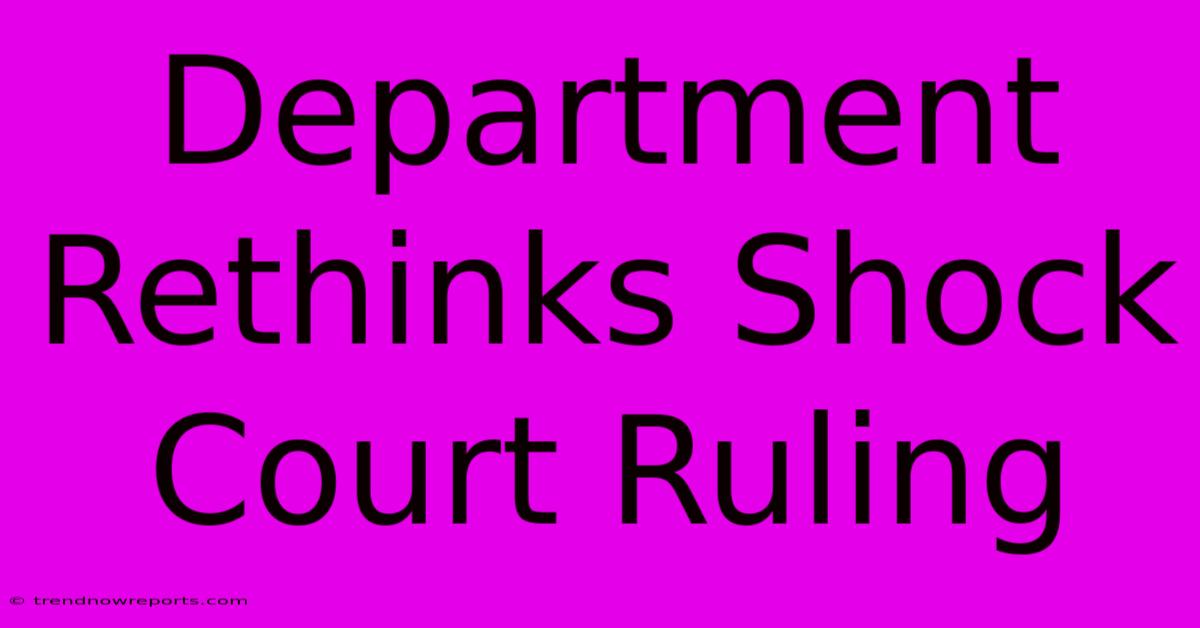Department Rethinks Shock Court Ruling

Discover more detailed and exciting information on our website. Click the link below to start your adventure: Visit My Website. Don't miss out!
Table of Contents
Department Rethinks Shock Court Ruling: A Total Curveball
Okay, folks, buckle up. This is a wild ride. Remember that whole thing with the Johnson vs. the Department of Redundancy Department lawsuit? Yeah, the one that totally blindsided us? I'm still reeling, honestly. It felt like someone dropped a freakin' anvil on my desk.
We're talking a major, major court ruling. The kind that makes you question everything you thought you knew about workplace safety regulations. And let me tell ya, it shook things up. Big time.
The Initial Fallout: Panic Stations!
Initially, it was pure chaos. Our legal team, bless their cotton socks, was scrambling. We were all on high alert. Emails flew faster than a greased piglet at a county fair. My inbox? Let's just say it resembled a digital dumpster fire. I swear, I spent half the day just deleting the panic-fueled forwards.
We had to completely rethink our entire safety protocol. The court's decision was...unexpected, to say the least. They ruled against a key aspect of our safety training program—the one we'd been using for, like, ten years! I was seriously questioning my whole career path. What was I doing with my life?
The thing that really stung was the implication that we hadn't been diligent enough. That we'd somehow failed our employees. That's the kind of stuff that keeps you up at night. We've always prided ourselves on workplace safety, always going above and beyond. And this ruling made it feel like we'd completely dropped the ball.
Rethinking Our Strategy: SEO and Employee Safety
This whole mess forced us to get serious about updating our safety protocols. But it also forced us to get serious about our online presence, specifically our SEO. See, we needed to not only fix our safety issues, but also manage the fallout online.
The negative press was brutal. We had to get ahead of the story and reclaim the narrative. So we implemented a multi-pronged strategy:
-
Content is King (and Queen!): We revamped our entire website, focusing on keyword research related to workplace safety and training. Think terms like "OSHA compliance," "employee safety training," "accident prevention," and "risk management." We also created tons of new content – blog posts, FAQs, videos – showcasing our commitment to safety.
-
Employee Testimonials: This was HUGE. We collected positive testimonials from our employees, highlighting their positive experiences with our improved safety training. It humanized the situation and showed we cared.
-
Community Engagement: We reached out to industry associations and other organizations to show our commitment to best practices. We had to rebuild trust, and that starts with transparency.
-
Internal Communications: Seriously, this is so vital! Clear, regular updates kept our employees informed and alleviated some of the initial panic. I know this seems obvious, but you'd be surprised how many companies mess this up.
Lessons Learned: Beyond the Legalese
Here's the kicker: this situation wasn't just about legal compliance, it was about reputation management. A court ruling like this can absolutely decimate your brand.
This experience taught me a ton about crisis management, SEO, and the importance of proactive safety measures. We learned that even if you think you've done everything right, there's always room for improvement. And frankly, the entire episode highlighted the crucial link between employee safety and a company's reputation and online presence. It wasn't just about fixing the problem—it was about being seen to be fixing it. And that means a proactive SEO and content strategy.
So, yeah. It was a rough patch. But we bounced back, stronger than ever. And we're definitely updating that safety training program. This is a reminder that even seasoned professionals can face unexpected challenges, and a comprehensive strategy is key to managing a crisis – both legally and online.

Thank you for visiting our website wich cover about Department Rethinks Shock Court Ruling. We hope the information provided has been useful to you. Feel free to contact us if you have any questions or need further assistance. See you next time and dont miss to bookmark.
Featured Posts
-
Morgan Freemans Incognito La Outing
Nov 27, 2024
-
Tmz Wendy Williams Incapacitated
Nov 27, 2024
-
Pedri Channels Iniesta Barcelona Style
Nov 27, 2024
-
Champions League Bratislava Xi Vs Milan
Nov 27, 2024
-
Four Dead After Red Sea Boat Sinks
Nov 27, 2024
